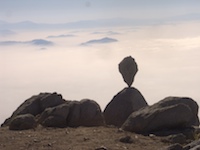As a preface, I haven't done much hiking in the San Gabriels since I was a Boy Scout in the seventies. I was a Wilderness Volunteer Ranger at San Gorgonio for a few years some time ago and I had somehow got the idea the San Gabriels, with all those highways running through them, weren't wild and remote enough (I was exclusively a backpacker, never day-hiked). So I drove past the San Gabriels every weekend to backpack in the San Bernardino Mountains.
After about ten years of not much hiking at all, I started day hiking this year and have just discovered the San Gabriels. I could kick myself for ignoring them all this time, though I've had a copy of Robinson's Trails of the Angeles for about 20 years. I started re-reading it this month.
I am winter hiking mostly to extend the hiking season, and am pretty new to it, certainly not nearly as experienced as most of the other folks here (and unlike some of you guys, I do NOT love snow). For my first real winter hike, I decided to climb Ontario Peak in the Cucamonga Wilderness.
The Icehouse Canyon parking lot is only about an 1:15 hour drive from my home in Costa Mesa (kick, kick!). The Baldy Visitors Center had opened a few minutes early, so I was on the trail by about 8:15am.
I had rented a set of crampons, hoping I wouldn't need them. In fact, the first half mile or so of the Icehouse Canyon trail, where it doesn't get much sunlight, was pretty icy and treacherous. I didn't bother with the crampons, since I was pretty sure I would have to remove them soon anyway, but I kept my ice axe handy and hobbled on up the trail until the ice gave way to soft snow. I only met about a half dozen other people on the trail on the way up to the Saddle, and one guy who was coming down. He was wearing a backpack that was at least 40 years old and had spent the night at the Saddle.
I walked fast up the canyon. I don't train during the week, but try to get a hard hike in every weekend. I was hoping this was enough to make it to the top, but wanted to make sure I was moving fast in the beginning in any case. In the past (with a heavy backpack) I would pace myself better, but lately during day hikes I have been having good luck just stomping up the mountain as quickly as possible, knowing I would slow down eventually. I am 45 years old and not in the best of shape.
My day pack is heavy, as I pack a lot of clothes and water, always prepared to spend the night on the mountain if necessary. For my first winter hike, I had a few heavier outer garments that I never removed from the pack, but I am reluctant to leave them behind as you never know when you might need them. I would like to lighten the pack and will have to do some hard thinking about what to bring and what to leave behind. Again, backpacking is easier: just bring everything you can think of; the frame pack makes it comfortable and you have all day to get where you are going.
I was happy with my progress up the canyon, until I hit those steep switchbacks below the Saddle. The snow was melting and there was no ice anywhere up there. I was still comfortable, but noticed myself slowing down considerably. When I finally got to the Saddle, there were two other dudes there and we were soon joined by another, all of us traveling solo. One was headed up the Three Tees Trail, another was going to Cucamonga Peak and I don't know what the third guy was up because he never said anything. I stopped and ate half a sandwich and drank some water.
The Three Tees trail, being more exposed to the sun, was probably a much easier climb than the Ontario Peak route I had chosen. Snow was deep(ish) towards Ontario Peak and apparently only two or at most three people had been up it since last weekend's storm. I put on my old gaiters (I have no idea where or when I acquired them; they didn't work very well) and headed up the trail.
In no time I was postholing through (relatively) deep snow. I tried to step where the others had gone before, but it was almost impossible to keep doing it for long. I had no trekking poles, and the ice axe wasn't really useful in the deep snow either. It was exhausting and awkward. After spending a half hour traveling 3/4 mile, I realized I was not going to make the summit by noon (my planned turnaround point; I didn't want to find myself slipping and sliding through the dark in the icy lower canyon). So I found an inviting knoll and sat down to eat the rest of my sandwich before heading back.
It was just under 40 degrees F up around the Saddle, cool enough for comfort while hiking but also warm enough to melt the snow. I never encountered any ice above the shaded lower canyon. I did encounter a lot of Koreans, though; of the twenty or so people I met on the mountain, more than half of them were Koreans, in multiple groups. When I asked the Visitors Center volunteers about it afterwards they told me the mountains are always full of Koreans, they love to hike. I had never heard of that, and certainly don't recall seeing any Koreans on San Gorgonio when I was a Volunteer Ranger there around 1990.
There was ice again in the shady part of the canyon; I doubt it had melted at all during the day. I was reluctant to fool around with crampons, so I pulled out the ice axe and again hobbled along as best I could. As I got closer to the parking lot, what was, at 8:00am, a cold and quiet winter wonderland was increasingly, by this time, a raucous playground for families with toboggans and sleds. Kids were all over the place, but hardly anyone ventured up the trail as far as halfway to the Wilderness Area sign.
I made a video of the hike. I mostly made it for friends and family who have never been up there, so I don't know how interesting it will be to you folks, but it might give you an idea of trail conditions at the various points up to and just beyond the Saddle.
Issues:
o If I'm going to keep doing this I will have to get some poles;
o I will also need to replace those worthless gaiters.
o The remedy I found for my hammertoe (a crippling problem I have been having lately) seemed to work pretty well for almost the entire trip, but I did find myself hobbling painfully across the parking lot at the end of the hike. Must keep trying things.
o My feet actually started getting cold in the deep snow! Need to do a better job of Sno-Sealing my boots (circa 1982 Vasque Cascades, resoled twice, very expensive to replace these days so I would like to avoid that), and also should remove the cushiony insoles and wear an extra pair of wool socks during winter hikes.
o Training on weekends might not be enough for winter mountaineering.
Edit: my very first attempt at converting a GPS track to a KMZ is here.
Ontario Peak attempt, Icehouse Saddle, 16 December 2007
-
EManBevHills

- Posts: 387
- Joined: Fri Sep 28, 2007 12:40 am
You came clean fast! 
I think you have a good grasp of some of the challenges of winter day hiking. I experienced some of what you did when I took a "snow-newbie" with me to San Gorgonio's Dry Lake on Sat. He had a blast, btw. Hadn't been there since 6th grade. A totally different experience.
Besides having great difficulty in regulating his temperature -- it was cold when we started and he overdressed -- he took too many "what ifs" with him. Only natural to have too much weight and unnecessary items.
As your winter experience grows, so will your confidence in leaving something behind that you've never used on all those prior trips. And it is considerably more efficient to travel with a regular partner since "team gear" can be split up. It is also much safer!
I think you have a good grasp of some of the challenges of winter day hiking. I experienced some of what you did when I took a "snow-newbie" with me to San Gorgonio's Dry Lake on Sat. He had a blast, btw. Hadn't been there since 6th grade. A totally different experience.
Besides having great difficulty in regulating his temperature -- it was cold when we started and he overdressed -- he took too many "what ifs" with him. Only natural to have too much weight and unnecessary items.
As your winter experience grows, so will your confidence in leaving something behind that you've never used on all those prior trips. And it is considerably more efficient to travel with a regular partner since "team gear" can be split up. It is also much safer!
-
Taco

- Snownado survivor
- Posts: 6136
- Joined: Thu Sep 27, 2007 4:35 pm
Sounds good! Learning is the best, whether you make it to a designated point or summit or not.
Nice video, BTW.
Nice video, BTW.
